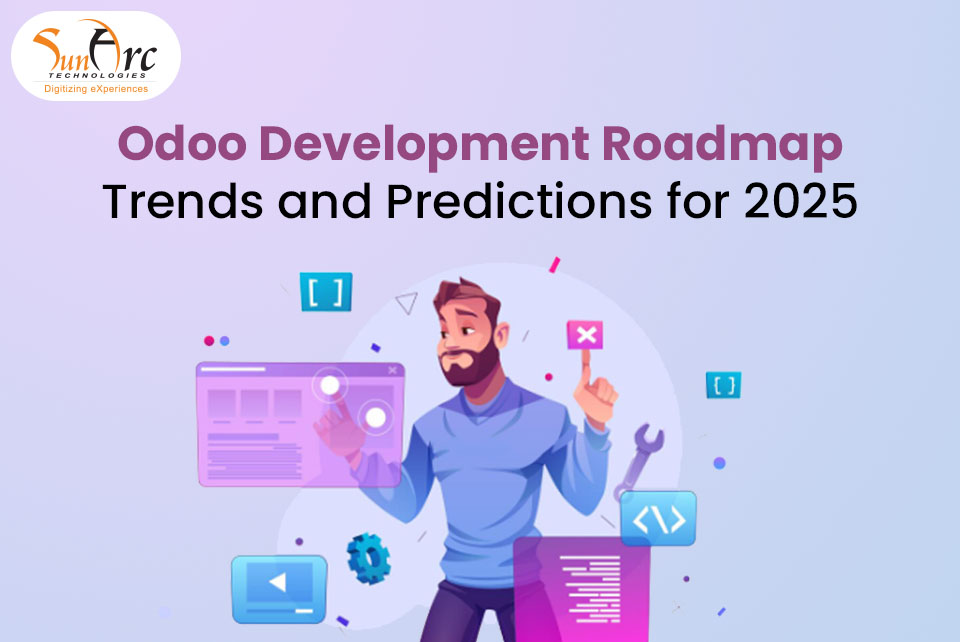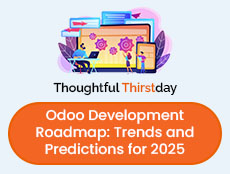The digital transformation scene keeps changing, and Odoo—once a simple open-source ERP solution—has grown into a full business management ecosystem. As we get closer to 2025, the Odoo Development Roadmap aims to use the latest technologies to bring more value to companies worldwide. With Odoo 18 just out and Odoo 19 on the way, businesses are seeing a platform that keeps pushing the limits in enterprise resource planning.
This blog looks at the key Odoo 2025 trends & development roadmap parts that companies should watch as they map out their digital shift plans. From AI add-ons to sector-specific tools, Odoo’s future aims to boost features, make things easier to use, and offer stronger business answers.

Key Features in Odoo 19: The Basis for 2025
1. AI and Automation
AI integration forms the heart of Odoo development trends for 2025. Odoo 19 has set up the basics with several AI-driven features that will grow in the next few years.
1. Intelligent Document Recognition (IDR): Better OCR tools now pull data from invoices, receipts, and other business papers more than before.
2. Predictive Analytics Dashboard: Business intel features now have models that look at past data to guess future sales, stock needs, and resource demands.
3. AI-Powered Customer Service: Smart reply systems and chatbots in the CRM and Help Desk parts use natural language tech to boost customer interactions.
4. Smart Workflow Automation: Process speedups now make choices based on old patterns and set business rules.
These features are just the start of Odoo’s AI journey. The Odoo 2025 roadmap points to more advanced AI integration across all modules.
2. Cloud-Native Architecture
Odoo 19’s updated structure adopts cloud-native ideas, paving the way for the Odoo enterprise solutions 2025 landscape:
1. Microservices Structure: Shifting from a single-block design to more flexible, stand-alone services that developers can roll out.
2. Containerization: Better Docker support and Kubernetes integration to offer more ways to deploy.
3. Serverless Computing Choices: Fresh options to deploy specific Odoo functions without managing the servers underneath.
4. Multi-Cloud Strategy Backing: Better tools for companies working across different cloud providers.
This change in structure plays a key role in making things bigger and faster, as outlined in the Odoo 2025 roadmap.
3. Better User Experience
Odoo 19’s user interface and experience have gotten a lot of attention, in line with Odoo’s focus on keeping things simple and boosting productivity:
1. New Mobile-First Design: A complete overhaul to ensure smooth use on all devices.
2. Dashboards You Can Tweak: More adaptable, widget-based dashboards letting users set up their own work areas.
3. All-in-One Communication Hub: A combined system for messages, emails, and alerts you can access from anywhere in the platform.
4. Smart Help When You Need It: Clever assistant features that offer relevant guidance based on what you’re doing.
These improvements to make things easier for users show Odoo’s dedication to creating business software that’s more intuitive and user-friendly, a trend that’s set to continue through 2025.
Industry-Specific Applications
Vertical specialization plays a crucial role in Odoo development trends, and 2025 will bring more advanced industry solutions:
1. Healthcare Management: Better systems to manage patient records, schedule appointments, and ensure compliance.
2. Advanced Manufacturing: Improved MRP features that connect with IoT and predict when maintenance is needed.
3. Retail and E-commerce Unification: Smooth experiences across both physical stores and online shops.
4. Professional Services Automation: Full systems to manage projects, track time, and handle billing for service companies.
5. Education and Training Management: Combining learning management systems (LMS) with the main HR and operations.
These specialized tools show how Odoo has grown from a basic business system to a platform with in-depth industry know-how built into its features.
What Odoo Implementation in 2025 Means for Businesses
1. Key Things to Think About
Companies looking at Odoo to help them go digital should keep these points in mind based on where Odoo is headed in 2025:
1. Going Digital Faster: Odoo’s growing features offer a full platform to speed up digital projects.
2. Overall Costs: The building-block approach lets companies invest smarter in tools that pay off right away.
3. Working with Other Systems: Better ways to connect and share data make it easier to link Odoo with existing setups.
4. Room to Grow: Clearer paths for businesses to expand from small to big while sticking with Odoo.
These strategic advantages give Odoo an edge as a compelling alternative to older ERP systems for companies that want flexibility and good value for money.
2. Ways to Implement:
The changing Odoo Development Roadmap points to several good practices for putting Odoo into action in 2025:
1. Step-by-Step Adoption Plan: Begin with the main modules and grow based on proven worth and how ready the organization is.
2. Cloud-First Setup: Use Odoo’s better cloud features to set up faster and cut down on complex infrastructure.
3. Design with Users in Mind: Boost adoption through tailored workflows and interfaces that match what users need.
4. Focus on Data Strategy: Make data quality and management a top priority to get the most out of Odoo’s AI and analysis tools.
These methods show that a successful Odoo rollout in 2025 will need more than just technical setup. It will also require changes in how the company works and aligns with its goals.
3. How Odoo Stacks Up
When companies look at Odoo business solutions for 2025 and compare them to options like SAP, Oracle, and Microsoft Dynamics, they see some key benefits:
1. Quick Updates: New features and fixes come out more often than with older ERP systems.
2. Easier to Start: Less money and hassle to get going for medium-sized companies.
3. Fits Your Needs: Can adapt to unique business ways without lots of custom coding.
4. Strong Support: A big group of developers, partners, and users who share tips and answers.
These elements give Odoo a growing edge as a choice for big companies that once had to stick with the usual top-level ERP providers.
Technical Trends Shaping the Odoo Ecosystem
1. Development Methodologies
The Odoo development trends for 2025 show big changes in how developers build and expand the platform:
1. API-First Development: New features now need to work with APIs from the start.
2. GitOps and DevOps Integration: Better tools to control versions, test code, and roll out updates .
3. Low-Code/No-Code Extensions: Stronger visual tools for non-tech staff to make changes.
4. Component-Based Architecture: Ready-made parts speed up custom work and keep things looking the same.
These new ways of working help the Odoo world grow faster and make changes that last longer.
2. Security and Compliance
As Odoo gains ground in enterprise settings, the Odoo 2025 roadmap focuses more on safety and following rules:
1. Zero-Trust Security Model: Full checks for all system actions.
2. Better Data Control: More detailed options to sort, keep, and guard data.
3. Rule-Following Frameworks: Ready-to-use settings and reports for GDPR, CCPA, and field-specific rules.
4. Always-On Safety Checks: Built-in scans for weak spots and rule-following.
These safety upgrades address the rising worries about data protection and following rules in business software.
3. Speed and Growth
The Odoo 2025 plans and future work include big tech improvements to handle large-scale business use:
1. Query Optimization Engine: Smart database query handling to boost performance with big datasets.
2. Distributed Processing Framework: Ability to run resource-heavy tasks in parallel.
3. Memory Management Improvements: Better handling of big transactions and many users at once.
4. Caching Strategy Enhancements: Advanced caching methods to cut down database strain and speed up response times.
These technical upgrades allow Odoo to meet the needs of bigger companies while keeping the quick responses expected in today’s apps.
The Community and Ecosystem Growth
1. Partner Network Growth
The Odoo development trends for 2025 include big changes in the partner ecosystem:
1. Vertical Specialization: Partners gain deeper knowledge in specific industries and use cases.
2. Implementation Methodology Standardization: More organized ways to ensure successful rollouts.
3. Managed Service Offerings: More choices for ongoing help fine-tuning, and oversight.
4. Co-Innovation Programs: Teamwork between Odoo, partners, and customers to tackle tricky needs.
This growing partner network plays a key role in backing Odoo implementation in 2025 across many business settings.
2. Open Source Community Growth
Even with its business success, Odoo’s open-source roots still play a big role in shaping its future plans:
1. Community Governance Evolution: Better ways to handle community input and decide which features to build first.
2. Education and Certification Programs: More training choices for developers and admins.
3. Regional Community Hubs: User groups and developer communities in new markets.
4. Contribution Recognition Systems: Better ways to thank and reward people who help out.
The lively open-source community remains a key advantage in the Odoo enterprise solutions 2025 scene, bringing new ideas and help that go beyond what other companies can offer.
Conclusion: Navigating the Future with the Odoo Development Roadmap
The expected Odoo development roadmap for 2025 goes beyond a simple update; it signals a big move to make Odoo the smart, all-in-one, and industrial-strength ERP platform of tomorrow. The main idea is to change from just handling business tasks to automating, forecasting, and fine-tuning them using AI smarts.
SunArc Technologies serves as a trusted guide to help you turn the latest innovations on the Odoo roadmap into real results that boost your business and improve how your organization runs.
In the end, the 2025 version of Odoo will run quicker, think smarter, and connect to way more things. For coders, partners, and companies, doing well will depend on getting ahead of these changes and putting money into the right people and plans to make the most of this strong, growing platform. The future of smart business operations is now, and Odoo is leading the way.

